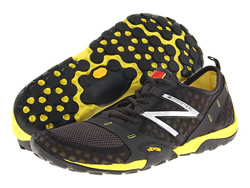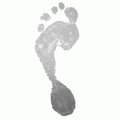Use these guidelines when choosing running shoes.
Relative to what you are currently using, look for shoes that:
- Minimize heel to toe drop
- Minimize material under foot
- Maximize room in the toe box

The aim is to reduce the barrier between your foot and the ground to enhance proprioception while still providing some cushion for protection and running economy.
A good fit requires adequate length and width to allow your toes to splay naturally while running. In addition, you want a shoe that moves with the foot rather than pulling away from it.
To check length: While standing in the shoes, there should be about a thumb’s width between your toes and the end of the shoe.
To check width: Take out the insole of the shoe and place it on the ground. Stand on the insole barefoot. If your fore-foot and toes extend beyond the sides of the insole, they are not wide enough. Look for shoes with a roomier toe box to better fit the width of your forefoot while standing. Sometimes this can be achieved by ordering a wider width.
When to try on shoes: Feet spread out during the day (and during runs) as you accumulate time on feet. So try on shoes later in the day (or after a run).
Ultimately, the job of a good pair of running shoes is to provide protection while allowing your feet to function naturally. This means your feet still need to do the work!
To strengthen your running muscles from your toes to your core, here are a few basic exercises and drills to incorporate into your daily training routine:
- Toe yoga
- Big toe push-downs
- Donkey kicks
- Lying hip abductions
- Front plank
- Glute bridge
- Balance drills – Do these on a rocker board to develop proprioception!
To enhance your mobility for more effective running, work to pass the three mobility tests demonstrated in the video below–especially before moving into minimalist shoes.







